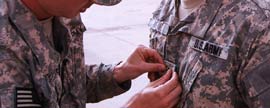Unfortunately Yes this can occur! The references for these actions are: AR 623-3, DA PAM 623-3, and AR 600-20
Basically the Commander can relieve the Leader because of personal or professional conduct, behavior, characteristics or performance of duty warrant a removal. The perception of such conduct can also be used as a reason. Basically when a Commander loses confidence in a Leader they can be relieved. Now there are certain steps that must be followed in most cases. Usually before a relief action the Soldier must be provided an opportunity to improve. In cases where the conduct is so severe this 30 day period can be waived but it must usually be waived by the 1st General Officer in the Chain of Command with General Courts Martial Authority. If the Leader believes this action is being taken unfairly he can request a Commander’s Inquiry and if this fails he can Appeal the NCOER. AR 623-3 and DA PAM 623-3 describe the process for both actions. There is also an NCOER appeals guide. I have attached one for you review. Here are some extracts of the doctrine that apply to this action.
EXTRACT FROM AR 623-3
3–55. “Relief for Cause” report (DA Form 2166–8)
A code 05, “Relief for Cause” NCOER, is required when an NCO is relieved for cause. An NCO can be relieved for cause regardless of the rating period involved; however, a waiver is required to render “Relief for Cause” NCOERs covering a period of less than 30 days. Relief for cause is defined as the removal of an NCO from a specific duty or assignment based on a decision by a member of the NCO’s chain of command or supervisory chain. A “Relief for Cause” occurs when the NCO’s personal or professional characteristics, conduct, behavior, or performance of duty warrants removal in the best interest of the U.S. Army (see AR 600–20). Additional considerations for these reports are described below
Extract FROM DA PAM 623-3
3–8. “Relief for Cause” noncommissioned officer evaluation report instructions
If a rated NCO is officially relieved (see AR 623–3) the following specific instructions apply to completing a relief report:
a. The rating official directing the relief will clearly explain the reason for relief in part IV, if the relieving official is the rater; if the relieving official is the senior rater, in part V, block e.
b. If the relief is directed by an official other than the rater or senior rater, the official directing the relief will describe the reasons for the relief in an enclosure (not to exceed one page) to the report (see AR 623–3 for a sample memorandum of “Relief for Cause” directed by a nonrating official).
c. Regardless of who directs the relief, the rater will enter the bullet, “The rated NCO has been notified of the reason for the relief” in part IV, block f.
d. The minimum rater and senior rater qualifications and the minimum rating period are 30 rated days (60 rated days for USAR TPU, DIMA, and drilling IR NCOs and ARNG NCOs). The fundamental purpose of this restriction is to allow the rated NCO a sufficient period to react to performance counseling during each rating period. Authority to waive this 30–day minimum rating period and rater and senior rater qualification period in cases of misconduct is granted to a general officer in the chain of command or an officer having general courts-martial jurisdiction over the relieved NCO. The waiver approval will be in memorandum format and attached as an enclosure to the report (see AR 623–3 for sample memorandum of 30-day minimum waiver).
Extract FROM DA PAM 623-3
2–17. Relief for cause
a. When a SC loses confidence in a subordinate commander’s ability to command due to misconduct, poor judgment, the subordinate’s inability to complete assigned duties, or for other similar reasons, the SC has the authority to relieve the subordinate commander. Relief is preceded with formal counseling by the commander or supervisor unless such action is not deemed appropriate or practical under the circumstances. Although any commander may temporarily suspend a subordinate from command, final action to relieve an officer from any command position will not be taken until after written approval by the first general officer (to include one frocked to the grade of brigadier general) in the chain of command of the officer being relieved is obtained. Any action purporting to finally relieve an officer from any command position prior to the required written approval will be considered for all purposes as a temporary suspension from assigned duties rather than a final relief from command for cause. If a general officer (to include one frocked to the grade of brigadier general) is the relieving official, no further approval of the relief action is required; however, AR 623–3 concerning administrative review of relief reports remain applicable.
b. If a relief for cause is contemplated on the basis of an informal investigation under AR 15–6, the referral and comment procedures of that regulation must be followed before initiating or directing the relief. This does not preclude a temporary suspension from assigned duties pending completion of the procedural safeguards contained in AR 15–6. Any action purporting to initiate or direct a relief for cause on the basis of an informal investigation under AR 15–6 taken prior to completion of the procedural safeguards of AR 15–6 will be considered for all purposes as a temporary suspension from assigned duties
Hope this helps!
Did you find this information useful? We appreciate your feedback!
TOP













